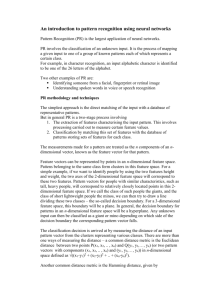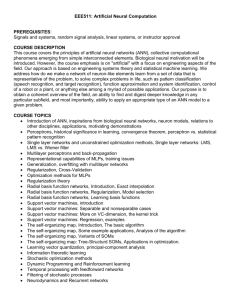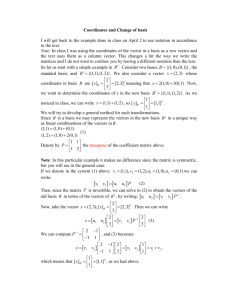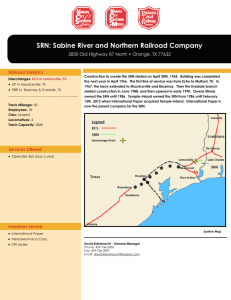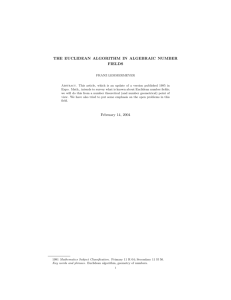Optimization With Neural Networks
advertisement
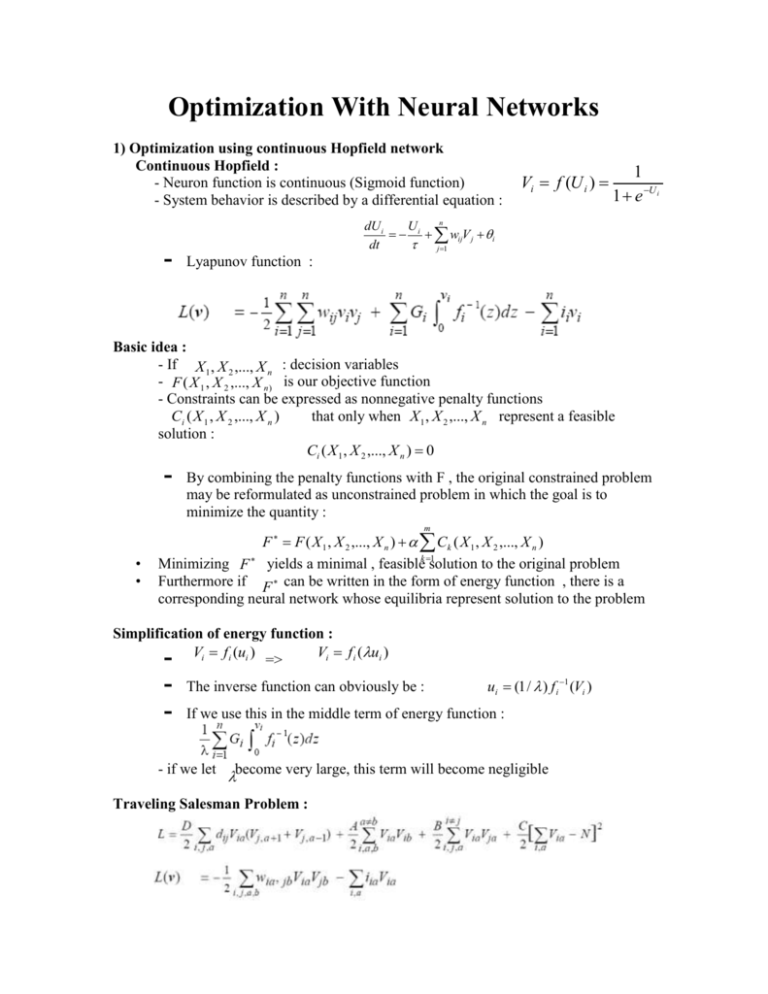
Optimization With Neural Networks 1) Optimization using continuous Hopfield network Continuous Hopfield : - Neuron function is continuous (Sigmoid function) - System behavior is described by a differential equation : - Vi f (U i ) 1 1 e U i n dU i U i wijV j i dt j 1 Lyapunov function : Basic idea : - If X 1 , X 2 ,..., X n : decision variables - F ( X 1 , X 2 ,..., X n ) is our objective function - Constraints can be expressed as nonnegative penalty functions that only when X 1 , X 2 ,..., X n represent a feasible Ci ( X 1 , X 2 ,..., X n ) solution : Ci ( X 1 , X 2 ,..., X n ) 0 - By combining the penalty functions with F , the original constrained problem may be reformulated as unconstrained problem in which the goal is to minimize the quantity : m • • F F ( X 1 , X 2 ,..., X n ) Ck ( X 1 , X 2 ,..., X n ) k 1 Minimizing F yields a minimal , feasible solution to the original problem Furthermore if F can be written in the form of energy function , there is a corresponding neural network whose equilibria represent solution to the problem Simplification of energy function : Vi f i (ui ) Vi f i (ui ) => - The inverse function can obviously be : ui (1 / ) f i 1 (Vi ) If we use this in the middle term of energy function : - if we let become very large, this term will become negligible Traveling Salesman Problem : = -C The Self-organizing Map A competitive network groups the inputs on the basis of similarity, namely via the correlation between the input patterns X and the weight vectors Tj. In the TSP context, the input patterns are the two-dimensional coordinates of the cities, and consequently,the Euclidean distance must be used as the similarity measure(maximizing the inner product is equivalent to minimizing the Euclidean distance only when all input and weight vectors are normalized to the same length). Moreover, the objective is now to map these coordinates onto a ring of output units, so as to define an ordering of the cities. Those observations suggest the use of Kohonen's self-organizing map.This model is aimed at generating mappings from higher to lower dimensional spaces, so that the relationships among the inputs are reflected as faithfully as possible in the outputs (topological mapping).As a consequence, topological relationships are established among the output units, and those relationships are respected when the weights are updated. Namely, the output units that are "close" to the winning unit, according to the topology, also update their weight vectors so as to move in the same direction as the winning unit. In the TSP context, a set of two-dimensional coordinates, locating the cities in Euclidean space, must be mapped onto a set of one dimensional positions in the tour, so as to preserve the neighborhood relationships among the cities. For example, the competitive network depicted in Figure 1 can be transformed into a self-organizing map, by choosing M >= N and by linking the output units to to form the ring O1-O2-...-OM-O1 (each output unit has two immediate neighbors). Figure1 First, the winning output unit is the one whose weight vector is closest in Euclidean distance to the vector of coordinates of the current city (current input pattern). Second, the neighbors of the winning unit also move their weight vector in the same direction as the winning unit, but with decreasing intensity along the ring. As a consequence, the winning unit j* satisfies dX,Tj* = minj dX,Tj , j=1,...,M , and the connection weights are then updated according to the formula Tj new = Tj old + m G(d'jj*) (X - Tjold) , where dX,Tj is the Euclidean distance between input vector X and weight vector Tj, and G is a function of the "proximity" of output units j and j* on the ring. Usually, the units on the ring are indexed from 1 to M, and d'jj* is based on that indexing, so that d'jj* = min (|j - j*|, M- |j - j*|) , where |x| denotes absolute value. In particular, the distance between a given unit and its two immediate neighbors on the ring is one. Obviously, the value of G must decrease as the d'jj* value increases. Moreover, the modifications to the weight vectors of the neighboring units should ideally be reduced over time. Multiple passes through the entire set of coordinates are performed until there is a weight vector sufficiently close to each city. Figure 2 is a good way to visualize the evolution of the selforganizing map. The little black circles on the ring now represent the output units, and the location of each output unit Oj is determined by its weight vector Tj. Figure 2: Evolution of the elastic net over time (a) (b) (c) and the final tour (d). Simultaneous Recurrent Neural Networks Simultaneous Recurrent Neural Network (SRN) is a feedforward network with simultaneous feedback from outputs of the network to its inputs without any time delay SRN Training The standard procedure to train a recurrent network is to define an error measure, which is a function of network outputs and modify the weights using a derivative of the error with respect to the weights themselves. The generic weight update equation is given by: Solving TSP with SRN Weight Adjustments: The formula used for weight adjustment based on the RBP algorithm is given by: The value of parameter e l will depend on the value of the error function, E. This parameter will have double index in our case as we have two-dimensional output matrix, i.e. eij

